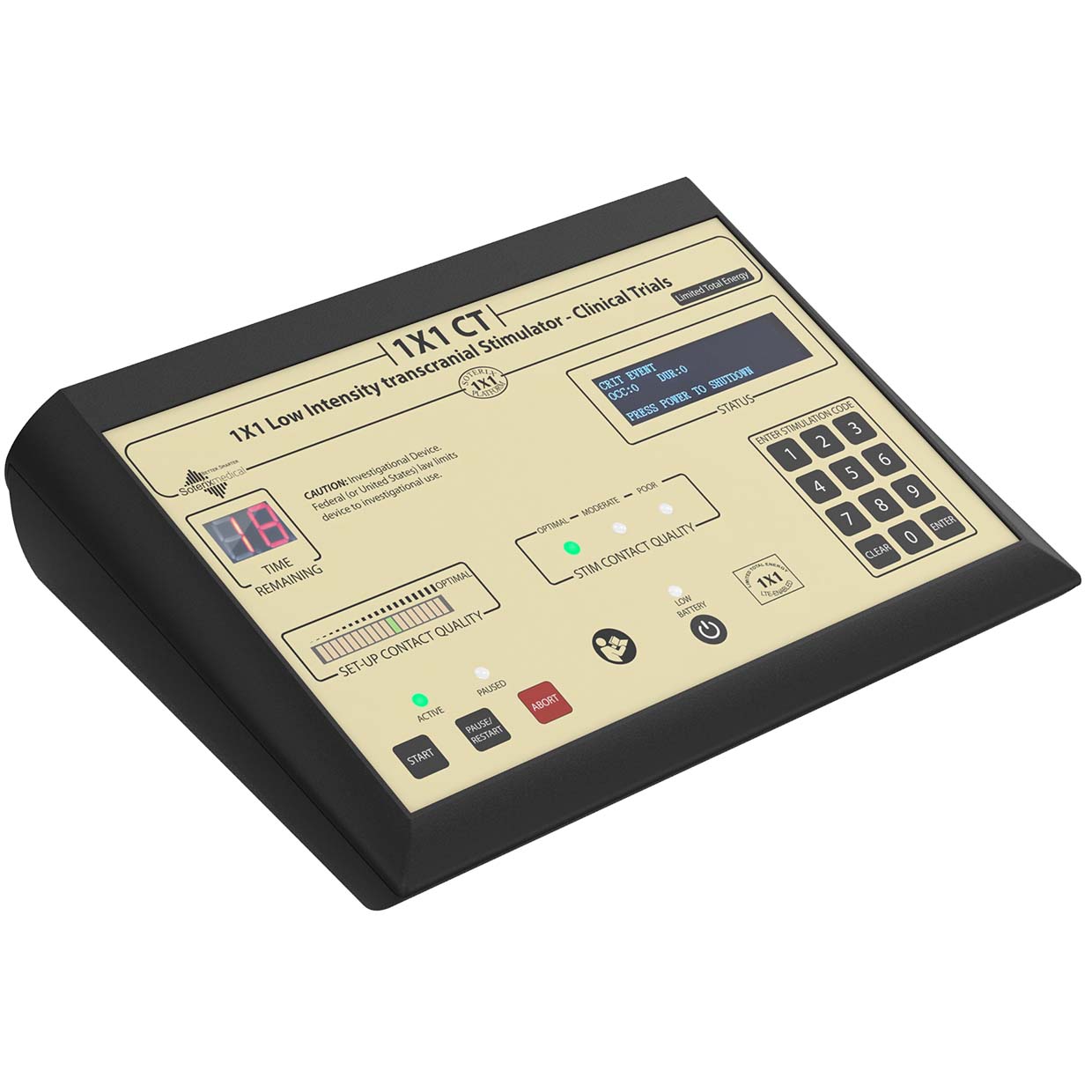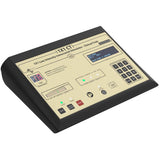The Soterix transcranial Direct Current Stimulator Clinical Trials (1x1-CT) system is the most advanced and customizable stimulation for true double-blind control trials. Each 1x1-CT unit is shipped configured to a specific trial or set of trials, including custom accessories, and relevant features to ensure the highest standards of reproducibility and safety, all without breaking the subject’s or operator’s blind
Soterix Medical Quality
The Soterix Medical brand represents the highest quality and standards in tES because each device is designed based on the latest science and biomedical engineering. The Open-Panel interface provides the simplest most-intuitive interface while embedded electronics work over-time to ensure precision and tolerability, even under unexpected conditions. Advancing the practice of tDCS requires devices and protocols integrating the latest advances in technology and science. Soterix Medical was founded to support this effort and continues to provide unparalleled support to every user - with devices and accessories that incorporate exclusive features for rigorous trial design, tolerated procedures, and reproducible protocols. Introduced in 2014, the 1x1-tES stimulator represents the most sophisticated stimulator ever built for tES while building on the validated 1x1 platform.
Industry Leading Precision and Control
The most essential feature of a programmable tES device is precision and control of the current output. The Soterix Medical 1x1 tES uses state-of-the-art electrical and biomedical engineering design to provide the highest temporal and intensity precision of any tES stimulation device: Adjustable output current in increments of 10 µA, 12 bit D/A, variable sampling time for accurate reconstruction of higher frequencies - 71 µs resolution for 200Hz signals.
Control means that across physiological loads (e.g. head size and electrode impedance), the target current is maintained. Soterix Medical is the only company that provides an independent current meter, the “True-Current” feature, which demonstrates reliability continuously during use. Researchers and clinicians used the Soterix Medical 1x1 tES when the highest quality stimulation signal is required.

Other commercial tES device at 150 Hz

Soterix Medical tES device at 150 Hz
Simple to use Open-Panel controls
The Soterix Medical 1x1 platform devices stand out for their simple controls and interfaces. Program the device precisely in seconds, with no complex drop-down menu, hidden settings, or need to establish a wireless connection with an external computer. The device program is clearly visible through the knob settings and backlit features like SmartScan and TrueCurrent. Waveform and frequency control knobs and displays make programming straightforward. With Soterix Medical Open-Panel, simplicity and clarity mean that set-up time and potential programming errors are reduced.
Device Features
Double Blind: Full integrated clinical trial support with subject codes and customized sham protocols. Clinician and patient blinded study for unbiased results
Smartscan Plus: Provides a continuous visual indication of electrode quality before and during stimulation. From pre-stimulation set-up, to during stimulation monitoring, to post-stimulation confirmation, the Soterix Medical SmartScan feature provides an intuitive and clear indication of electrode contact quality. Use the SmartScan during set-up to adjust electrodes and head-gear for optimal fit. During stimulation, SmartScan provides a constant indication of electrode quality and can be monitored during adjustments (e.g. addition of saline to drying electrodes). After stimulation, SmartScan confirms a successful trial. Because “resistance” is not meaningful for tDCS, SmartScan was developed by Soterix Medical engineers to provide clinical investigators with a simple to read indication of contact quality.
Pause: A simple feature that minimizes dropout in double-blind clinical trials. Sometimes trivial issues require stimulation interruption or adjustment. Rather than abort a session which can result in subject exclusion or data confounds, the PAUSE feature was developed in collaboration with clinical trial experts running higher-volume or longer duration trials. For both automatic (under SmartScan) and user initiated PAUSE, this exclusive feature intelligently avoids breaking sham even in double-blind trials.
LTE-CT: Limited Total Energy for Clinical Trials. A Soterix Medical exclusive feature, LTE-CT adapts our proprietary LTE technology for higher stimulator outputs needed in the most advanced tDCS clinical trials. For current intensities of 2.0 mA and 2.5 mA, LTE-CT provides robustness and safety-factors essential for large scale tDCS clinical trial. For current intensities > 2.5 mA, please contact Soterix Medical.
Operator Blinding for True Sham
Each Soterix Medical CT unit is programmed, validated, and shipped directly from the factory with study and site-specific Stimulation Codes. These stimulation codes are developed based on the lead investigators clinical study plan and can be disclosed, encoded, or un-encoded to the study coordinator or the statistician. However, for true operator blinding, stimulation codes are just the beginning. For true operator blinding, device operation must balance providing a continuous indication of stimulation and electrode quality status for safety, without betraying whether the stimulation session is real or sham. For example, experienced operators will understand what change in electrode impedance is expected during an active tDCS session since the current passage itself generates characteristic impedance decreases – thus breaking blind on conventional stimulators. Similarly, in real but not sham conditions when a faulty condition is detected, such as high voltage, requiring corrective action, the blind on the conventional stimulator is broken. The 1x1-CT stimulator provides a continuous indication of electrode quality through the exclusive SMARTscan-PLUS. Once the real and sham study protocols are set, Soterix Medical biomedical engineers tune the SMARTscan-PLUS algorithms to provide a simple indication of stimulation conditions that is consistent across real and sham conditions. New operators can rely on the SmartSCAN-PLUS indicators: “Green” Optimum: Within defined range; “Yellow” Moderate: Caution or attention warranted; “Red” Critical (LTE): Outside of defined range. For each trial, the operating manual will indicate requisite corrective steps. An experienced operator will not be able to distinguish real from sham sessions. True operator blind is thus achieved without compromising subject monitoring.
Subject Blinding For True Sham
Because non-invasive brain stimulation, such as tDCS, requires delivery of energy through the scalp to the brain, the design of appropriate sham controls is pivotal for reliable clinical trial results. Two complementary approaches can be taken. In the sham study, skin sensation should be maximized while minimizing current delivery to the brain. In the real study arm, sensation should be reduced using optimized ramp waveform and electrodes, while maintaining brain stimulation dose. If the active arm can be reduced to levels where stimulation is imperceptible to a majority of subjects, the sham arm becomes trivial to design. Conversely, electrode waveforms can be designed to enhance the sensation during the sham arm, without significant brain current flow. Indeed, many of the processes used to reduce sensation during the active arm during full intensity stimulation, can be “reversed” to increase sensation in the sham arm even during weak stimulation. The most straightforward tDCS sham includes a transient ramp on and off. However, even here there are several permutations including the rate of ramp increase, rate of ramp decrease, the maximum intensity of ramp (which may or may not match real stimulation intensity), and the timing and number of ramps. A transient ramp may be applied only at the start of stimulation, only at the start or end, or at intermittent (even randomized) points during the session.
Soterix Medical EASYpads are designed to minimize sensation consistently across subjects while allowing reproducible and controlled set-up. Soterix Medical EASYpads are the standard choice for single and multi-center tDCS clinical trials. Soterix Medical SHAMpads are the first tDCS electrodes to include built-in scalp shunting paths, that are controlled by the CT stimulator and are operator blind. During the active arm, SHAMpads deliver current through HD-electrode functional sets, which mimic the current delivery of pad stimulation but are imperceptible for a majority of conventional tDCS protocols. During the sham arm, SHAMpads shunt current under the electrodes allowing the reproduction of any sensation level with no brain current flow. SHAMpads are compatible only with the Soterix Medical 1x1-CT unit and Soterix Medical HD-tDCS neuromodulation systems.
Avoid Subject Drop-Out With PAUSE and LTE
Especially for trials where recruitment is challenging or where multi-sessions with each subject make drop-out costly, Soterix Medical PAUSE and LTE features are enabled on the 1x1-CT. For example, pivotal trials often use multi-session stimulation over multiple days to enhance effects and may further employ a cross-over design – in such situations, the need to stop or interrupt stimulation on a single session can result in costly subject drop-out or confounding of results across the entire analysis. Furthermore, especially in large trials, interruptions in stimulation due to electrode-quality or subject concerns may occur. Soterix Medical biomedical engineers will work with study’s lead investigator's to design hardware and software that minimizes the occurrences of interruptions and allows for controlled, managed, and documented interruptions.
Minimize the occurrence of interruptions: Though designed for stimulation in susceptible populations, Soterix Medical LTE can be adapted for all clinical trials to minimize interruptions – under high resistance conditions stimulation intensity is automatically reduced while the operator is alerted to take corrective actions. The 1x1-CT monitors, records, and provides a coded summary for study coordinators for post-session analysis. The 1x1-CT intelligent sham feature ensures that alerts are provided at an equal rate under Real and Sham conditions. Allow for controlled interruptions: The Soterix Medical PAUSE feature was developed to allow for controlled interruptions without the need to re-start stimulation or remove the subject from the trial analysis. Activation of PAUSE, ramps down stimulation in a prescribed manner (or simulates ramp-down settings for the sham case), thus allowing the operator to address electrode or subject controls. Re-pressing PAUSE, allows the operator to resume the session. If stimulation electrode quality condition goes out of range “Red” (LTE-critical event) and stays out of range for an extended period of time, PAUSE is automatically activated, and current ramps down. This feature ensures subject safety/comfort by making sure that “out-of-range” stimulation does not continue for prolonged periods. The number of critical events per session and the time spent in the critical event mode are recorded by the CT unit and encoded. Like with the LTE feature, the clinical trial is not designed with the expectation PAUSE will be required but, none-the-less, the PAUSE feature prevents either unnecessary subject drop-out or operators improvising steps in a manner that may compromise trial integrity. Soterix Medical features LTE and PAUSE can be enabled on any 1x1-CT unit.

















